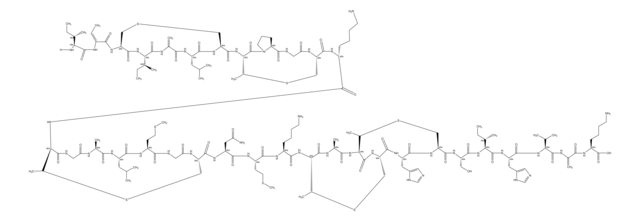63978
(RS)-(Methylencyclopropyl)-essigsäure
analytical standard
Anmeldenzur Ansicht organisationsspezifischer und vertraglich vereinbarter Preise
Alle Fotos(1)
About This Item
Empirische Formel (Hill-System):
C6H8O2
CAS-Nummer:
Molekulargewicht:
112.13
Beilstein:
1927126
MDL-Nummer:
UNSPSC-Code:
85151701
PubChem Substanz-ID:
NACRES:
NA.24
Empfohlene Produkte
Qualität
analytical standard
Qualitätsniveau
Assay
≥95.0% (HPLC)
Haltbarkeit
limited shelf life, expiry date on the label
Methode(n)
HPLC: suitable
gas chromatography (GC): suitable
Anwendung(en)
food and beverages
Format
neat
Lagertemp.
−20°C
SMILES String
OC(=O)CC1CC1=C
InChI
1S/C6H8O2/c1-4-2-5(4)3-6(7)8/h5H,1-3H2,(H,7,8)
InChIKey
QJBXAEKEXKLLLZ-UHFFFAOYSA-N
Anwendung
Hypoglycin A wird durch Transaminierung und oxidative Decarboxylierung zu Methylen-cyclopropylessigsäure (MCPA) metabolisiert. MCPA bildet nicht metabolisierbare Carnitin- und Coenzym A (CoA)-Ester und senkt so den Level dieser Cofaktoren im Gewebe, so dass sie für andere biochemische Reaktionen weniger verfügbar sind.
(RS)-(Methylenecyclopropyl)acetic acid (MCPA), an inhibitor of multiple acyl-CoA dehydrogenase enzymes, is derived from hypoglycin A metabolism. MCPA forms non-metabolizable carnitine and coenzyme A (CoA) esters thereby depressing tissue levels of these cofactors and making them less available for other biochemical reactions. (RS)-(Methylenecyclopropyl)acetic acid may be used as a reference material during the analysis of MCPA.
Refer to the product′s Certificate of Analysis for more information on a suitable instrument technique. Contact Technical Service for further support.
Verpackung
Bottomless glass bottle. Contents are inside inserted fused cone.
Empfohlene Produkte
Find a digital Reference Material for this product available on our online platform ChemisTwin® for NMR. You can use this digital equivalent on ChemisTwin® for your sample identity confirmation and compound quantification (with digital external standard). An NMR spectrum of this substance can be viewed and an online comparison against your sample can be performed with a few mouseclicks. Learn more here and start your free trial.
Choose from one of the most recent versions:
Besitzen Sie dieses Produkt bereits?
In der Dokumentenbibliothek finden Sie die Dokumentation zu den Produkten, die Sie kürzlich erworben haben.
K Y Tserng et al.
Biochemistry, 30(44), 10755-10760 (1991-11-05)
To study the structure-activity relationship between pentanoic acid analogues and the inhibition of fatty acid oxidation, a number of 4-pentenoic and methylenecyclopropaneacetic acid derivatives were prepared. All compounds inhibited palmitoylcarnitine oxidation in rat liver mitochondria, with 50% inhibition occurring at
Methylenecyclopropaneacetic acid, a metabolite of hypoglycin.
C Von Holt
Biochimica et biophysica acta, 125(1), 1-10 (1966-08-03)
David Grünig et al.
Biochemical pharmacology, 177, 113860-113860 (2020-03-14)
Treatment with valproate is associated with hepatic steatosis, but the mechanisms are not fully elucidated in human cell systems. We therefore investigated the effects of valproate on fatty acid and triglyceride metabolism in HepaRG cells, a human hepatoma cell line.
The antagonism of the toxicity of hypoglycin by glycine.
S S Al-Bassam et al.
Biochemical pharmacology, 30(20), 2817-2824 (1981-10-01)
Hypoglycin and metabolically related inhibitors.
D Billington et al.
Methods in enzymology, 72, 610-616 (1981-01-01)
Unser Team von Wissenschaftlern verfügt über Erfahrung in allen Forschungsbereichen einschließlich Life Science, Materialwissenschaften, chemischer Synthese, Chromatographie, Analytik und vielen mehr..
Setzen Sie sich mit dem technischen Dienst in Verbindung.







